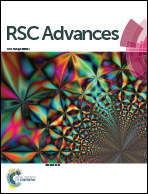In vivo characterization of electroactive biofilms inside porous electrodes with MR Imaging†
Abstract
Identifying the limiting processes of electroactive biofilms is key to improve the performance of bioelectrochemical systems (BES). For modelling and developing BES, spatial information of transport phenomena and biofilm distribution are required and can be determined by Magnetic Resonance Imaging (MRI) in vivo, in situ and in operando even inside opaque porous electrodes. A custom bioelectrochemical cell was designed that allows MRI measurements with a spatial resolution of 50 μm inside a 500 μm thick porous carbon electrode. The MRI data showed that only a fraction of the electrode pore space is colonized by the Shewanella oneidensis MR-1 biofilm. The maximum biofilm density was observed inside the porous electrode close to the electrode-medium interface. Inside the biofilm, mass transport by diffusion is lowered down to 45% compared to the bulk growth medium. The presented data and the methods can be used for detailed models of bioelectrochemical systems and for the design of improved electrode structures.



 Please wait while we load your content...
Please wait while we load your content...